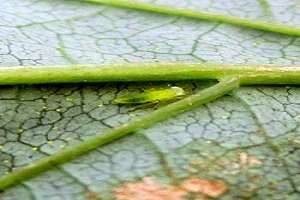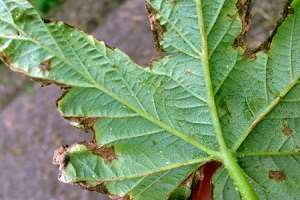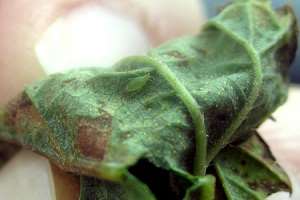

Damson hop aphids were observed in higher numbers as harvest approached and some growers had problem infestations at harvest. Again, we must look at the lifecycle of the pest to determine if a post-harvest treatment could help keep numbers down next season. Hop aphids overwinter as eggs on Prunus species (genus of trees and shrubs that includes plums, cherries, peaches, nectarines, apricots and almonds). In early spring, eggs hatch into stem mothers, which give birth to wingless females that feed on the Prunus host. In May, winged females are produced and travel to hop plants where additional generations of wingless females are produced. As cold weather approaches, winged females and males are produced, move back onto a Prunus host, mate and lay eggs for before winter. We expect that this migration away from hops and onto plants in the Prunus genus occurs sometime in September, making post-harvest treatments ineffective during most seasons.

Twospotted spider mites were an issue for some growers this season. Again, if we examine the lifecycle of the pest we can make better decisions about the potential impact of post-harvest management. Hops are a unique situation when it comes to mite management. Many horticultural crops use post-harvest treatments in infested sites to reduce overwintering populations, but hop growers remove the plant itself quite early in the season, likely removing a large portion of the mites with it. Twospotted spider mites that remain overwinter as mated females on plant debris and trellis structures in the hopyard.
Mites remaining in the hopyard are susceptible to miticide applications, but likely account for a relatively small number in fall when they are beginning to migrate to overwintering sites. Unless the infestations were at an economically significant level, miticide applications should be avoided if possible. Refer to the MSU Extension article, “Twospotted spider mite numbers up in hopyards,” for more information on managing twospotted spider mites.

Sanitize and fertilize in the fall
Growers should also consider the importance of sanitation at this time. Removal of all bines and leaves from the hopyard is recommended after the first hard freeze. Plant tissues can harbor insects and disease and should be removed, fully composted, buried or burned. Growers who did not harvest this year (as in first year hops) are advised to remove aerial plant parts after a hard frost to prevent increased pest and disease pressure next season.
Growers planning to utilize compost fertilizer can apply it this fall. Recommendations from the west suggest applying a couple of shovels full directly onto and around the crown. Growers may also consider sub-soiling between rows in areas in need of better drainage, applying herbicides for perennial weed control, and removing unproductive or diseased crowns.
According to MSU Extension educator Lyndon Kelley, trickle and drip lines and tape are designed to be self-draining, but manifolds and supply systems need attention to make sure no water pockets remain to freeze. Winter rodent damage can turn usable drip tape and trickle line into junk rapidly. Lines that are to be moved for next year are best stored in the barn. Lines overwintering in the field stand less rodent damage if not covered by plastic, plant material or mulch. To read more about preparing irrigation systems for winter, refer to the MSU Extension article, “Protecting irrigation equipment from winter damage.”
Take time to evaluate the season
Lastly, it is well worth a grower’s time to set aside a moment to reflect on the season. Take note of trouble areas in the hopyard and consider planning how to address pest or nutrient issues in the following season. It is also recommended growers review their spray records to ensure they are complete, and begin to investigate a food safety plan for next season. For more information on record keeping, visit the MSU Pesticide Safety and Education Resources webpage.
This material is based upon work supported by the National Institute of Food and Agriculture, U.S. Department of Agriculture, under Agreement No. 2015-09785. Any opinions, findings, conclusions, or recommendations expressed in this publication are those of the author(s) and do not necessarily reflect the view of the U.S. Department of Agriculture.
Source: msu.edu